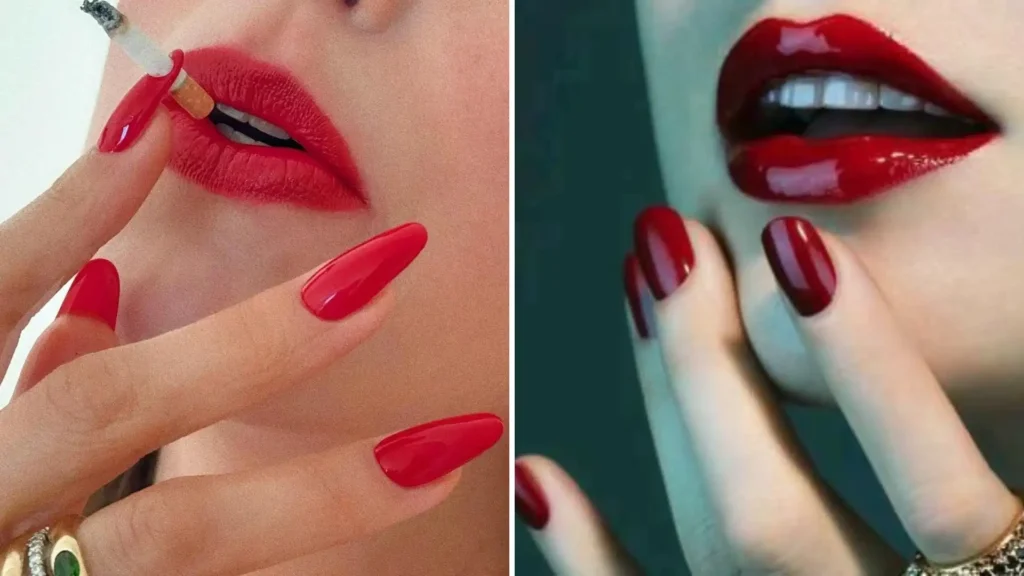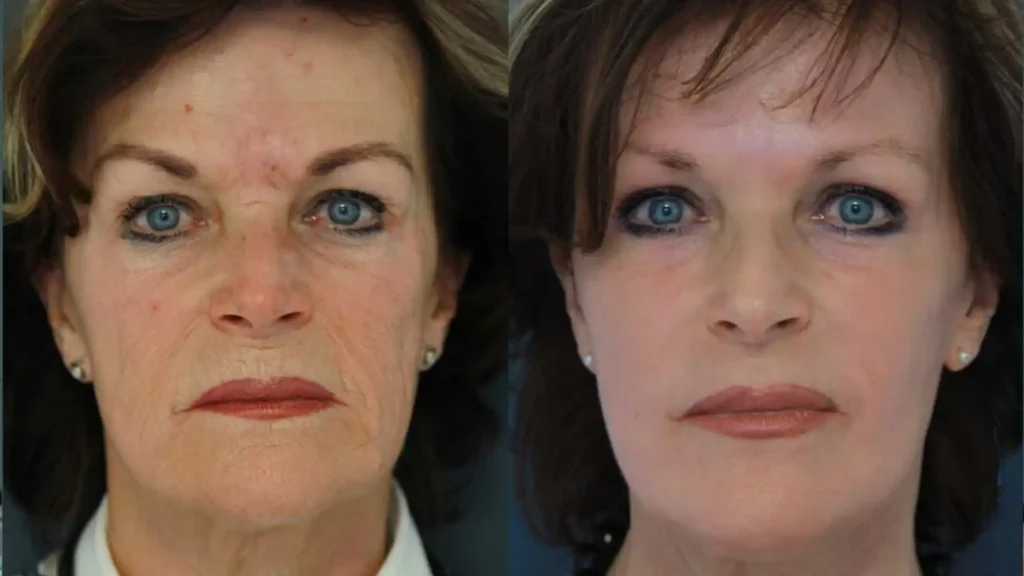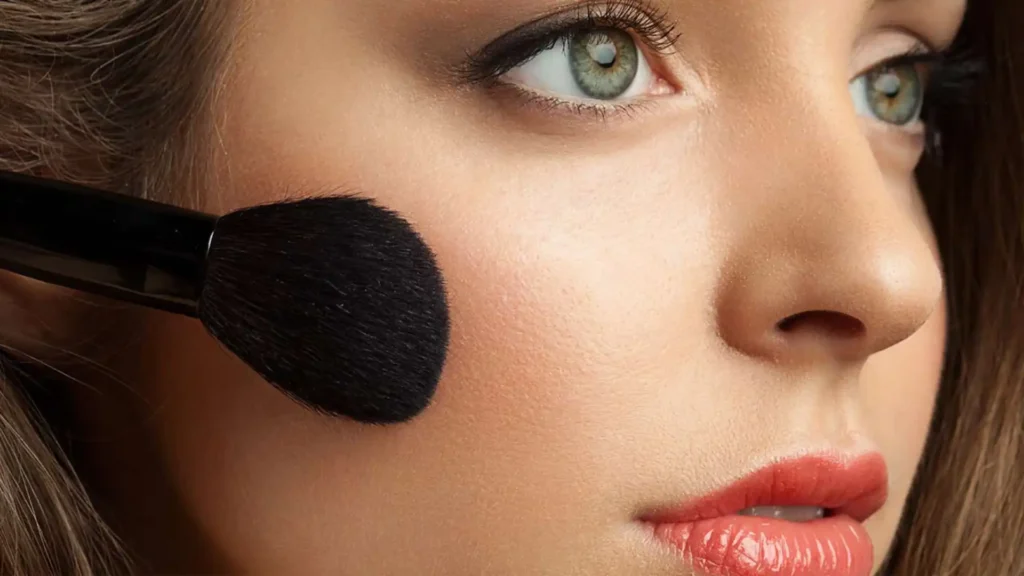As you age, you might notice jowls forming. This can be due to genetics, aging, and lifestyle choices. Jowls can start in the 40s, thanks to genetics and lifestyle. Simple steps like facial exercises and skincare can help tighten your jawline, making you look younger.
Understanding why jowls form and taking action can help reduce them. Facial exercises, skincare, and a healthy lifestyle can make you look younger. Drinking water, eating foods rich in antioxidants, and using SPF daily can also keep your skin elastic and protect it from the sun.
Key Takeaways
- Jowls can start developing in individuals as early as their 40s, influenced by genetics and lifestyle factors.
- Simple solutions like facial exercises and skincare routines can help tighten the jawline.
- Incorporating jowls reduction techniques into your daily routine can make a significant difference in the way you look and feel.
- Regular hydration, antioxidant-rich foods, and consistent application of SPF can help maintain skin elasticity and protect against sun damage.
- Non-surgical options, such as dermal fillers and ultrasound therapy, can provide effective solutions for jowls reduction.
- Skincare routines and facial exercises can be used in conjunction with non-surgical options for optimal results.
Understanding Jowls and Their Formation
Understanding jowls is key to finding ways to address them. Jowls often form due to aging, where skin loses its elasticity and firmness. This happens because collagen and elastin break down. Genetics also play a big role, as some people are more likely to get jowls.
The aging process and genetics combine to cause jowls. After 20, skin loses about 1% of collagen each year. This loss leads to sagging skin and jowls. Knowing these causes helps in finding effective solutions.
Genetics affect how fast skin ages and the chance of getting jowls. While aging is a main cause, genetics can make some get jowls sooner. Skin thickness and collagen production can be influenced by genetics, making some more likely to get jowls.
Signs You’re Developing Facial Jowls
As you age, your face may change, showing sagging skin and a less defined jawline. These signs mean you might be getting facial jowls. Jowls are a common sign of aging and happen to everyone at some point.
The loss of collagen and elastin in the skin causes sagging jowls. This gets worse with age. Facial changes, like a softer jawline, also show jowls are coming.
Less collagen and elastin means skin loses its elasticity with age. Genetics can also affect when jowls appear, especially if your family has them.
Exercising, protecting your skin from the sun, and eating well can help slow aging. Big weight changes can make jowls more noticeable. Smoking speeds up aging and makes jowls worse, studies show.
Knowing these signs and taking steps to prevent them is key. By understanding jowls and preventing them, you can keep your jawline defined and look younger. If you’re worried about jowls or want to prevent them, talk to a healthcare expert or a plastic surgeon like Dr. Scott Miller. He specializes in making faces look younger and can offer advice and treatments.
The Science Behind Skin Sagging and Jawline Definition
As you get older, your skin makes less collagen and elastin. This makes your skin less elastic and firm. This loss of collagen and elastin is a big reason why jowls form, as your skin starts to sag and lose shape.
Facial muscles also play a part in skin sagging. Their movement and tension can change how your skin looks. Things like sun exposure and smoking can also harm your skin and make it sag more.
To keep your skin healthy and your jawline defined, knowing about collagen and elastin is key. These proteins are what make your skin strong and elastic. But, as you age, your body makes less of them. Protecting your skin from the environment and boosting collagen and elastin can help keep your skin looking good and reduce jowls. Drinking plenty of water and eating a diet full of lean protein, fruits, and veggies can also help your skin.
There are also treatments and products that can help make more collagen and elastin. This can make your skin firmer and reduce jowls. Combining these with a healthy lifestyle and good skincare can help keep your jawline sharp and your skin healthy. Always use sunscreen with at least SPF 30 and don’t smoke to avoid early aging and skin damage.
Simple Daily Exercises to Tighten Your Jawline
Working towards a more defined jawline? Simple daily exercises can help a lot. Facial yoga, neck stretches, and jaw exercises are great for tightening your jawline and reducing jowls. It’s important to do these exercises every day to see results.
Experts say to exercise for 30 minutes a day, six days a week. This will help you see big changes.
Doing jawline exercises like the “Chin Lift” and “Jawline Tightener” can help with TMJ issues. Neck stretches, like the “Neck Stretch,” can also improve skin elasticity. Facial yoga targets 57 face and neck muscles, helping to reduce sagging and improve skin.
When doing these exercises, be gentle and avoid overdoing it. Overexertion can harm your jaw joints. By adding facial yoga, neck stretches, and jaw exercises to your daily routine, you can get a more defined jawline and less jowls. Start slow and gradually increase your exercises for the best results.
Dietary Changes That Combat Sagging Skin
To get healthier, firmer skin, focus on what you eat. A balanced diet full of nutrients is key. Avoid foods high in sugar and fats, as they harm your skin.
Eating foods rich in omega-3s, like fatty fish, strengthens your skin. Foods packed with antioxidants, like pomegranates and dark chocolate, protect your skin from damage. Drinking enough water keeps your skin elastic and firm.
Also, eating foods with monounsaturated fats, like olive oil, slows down skin aging. Cutting down on sugar is crucial to prevent skin sagging. By eating right, you can fight sagging skin and get a more defined jawline.
Essential Nutrients for Skin Firmness
Vitamin C, zinc, and omega-3s are vital for firm skin. You can find them in citrus fruits, leafy greens, and fatty fish. Adding these to your diet boosts collagen and reduces wrinkles.
Foods to Avoid
Stay away from foods high in sugar and fats to protect your skin. Avoid processed snacks, sugary drinks, and fried foods. Healthy eating promotes skin health and prevents sagging.
Hydration Requirements
Drinking enough water is crucial for skin health. It keeps your skin hydrated and plump, reducing wrinkles. Drink at least eight glasses of water a day. Avoid sugary drinks and caffeine, as they dry out your skin.
Professional Treatments for Jowl Reduction
Looking into ways to reduce jowls? Professional treatments offer a range of options. You can choose from non-invasive methods like dermal fillers and chemical peels. Or, you might consider more invasive procedures such as facelifts.
Dermal fillers give quick results and can last from six months to two years. You’ll need to go back for regular appointments to keep the look you want.
Non-invasive treatments like Ultherapy and Thermage can also help. They take 30 to 90 minutes and you won’t need much time to recover. Facelifts, however, can last up to 15 years and tackle all jowl-related issues. It’s smart to talk to a pro to find the right treatment for you.
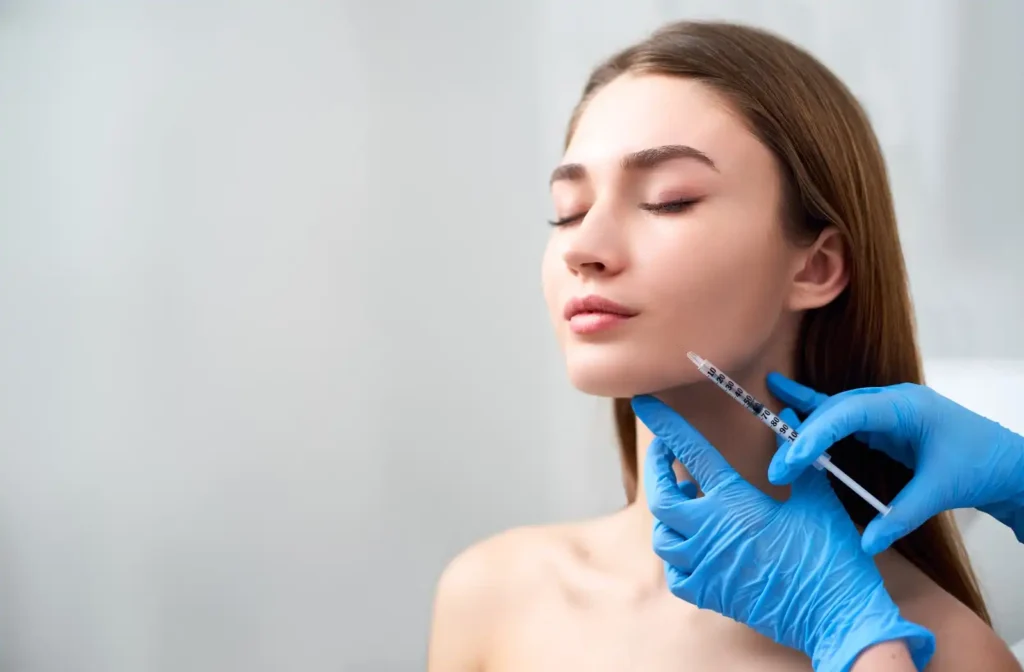
Thinking about professional treatments? It’s important to know the pros and cons of each. Dermal fillers and non-invasive treatments can make a big difference. But, facelifts might be better for those with more noticeable jowls.
By learning about the different professional treatments, you can choose the best one for a tighter, more defined jawline.
Natural Remedies to Address Facial Sagging
Looking for ways to fight facial sagging and jowls? Try natural remedies. They work well with other methods for a complete approach. Face masks, massages, and herbal treatments are great for reducing jowls.
Face massages boost blood flow and collagen, tightening the skin. Use gentle strokes, focusing on your jaw and chin. Herbal treatments like green tea and chamomile make soothing masks that firm the skin.
DIY face masks with honey, avocado, and oatmeal can also help. They give your skin nutrients and moisture, making it more elastic and firm. Adding these natural remedies to your skincare routine can help fight facial sagging and jowls.
Always pick natural ingredients that are gentle and right for your skin. With regular use and patience, you’ll see your skin improve and sagging signs lessen. Choose from face masks, massages, or herbal treatments to get a firmer, younger jawline.
Lifestyle Habits That Contribute to Jowl Formation
As you get older, some habits can make jowls more noticeable. Smoking, for example, can make your skin look older than it is. It damages the skin’s elasticity and collagen, causing it to sag and lose its shape.
Not protecting your skin from the sun is another bad habit. UV rays can harm your skin, making it lose its firmness. Using sunscreen with at least SPF 30 every day can help prevent this. Also, sleeping right can help reduce wrinkles and lines that lead to jowls.
Changing these habits can help fight or lessen jowls. Quit smoking, use sunscreen, and sleep well. A healthy lifestyle, balanced diet, and exercise can also help keep your jawline looking good. It’s important to watch your habits and take care of your skin to stay young-looking.
Skincare Products That Target Sagging Jowls
Skincare products can help with sagging jowls. Look for firming creams, serums, and moisturizers. They are made to tighten and firm the skin, making jowls less noticeable.
These products often have ingredients like retinol, peptides, and hyaluronic acid. These help improve skin elasticity and firmness.
Some moisturizers combine peptides and hyaluronic acid to reduce wrinkles and fine lines. Serums with collagen-stimulating ingredients can also firm the skin, especially in the cheek and jowl areas. Firming creams, like those with MicroDipeptide229, visibly firm the skin, especially on the cheekbones and jawline.
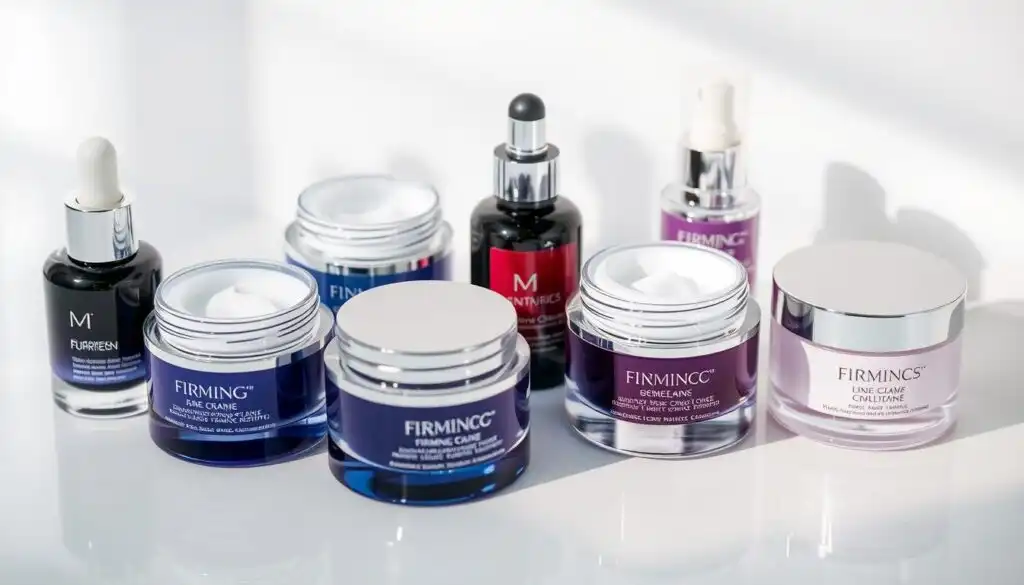
When picking a skincare product for sagging jowls, think about your skin type and concerns. For mature skin, look for antioxidants and hyaluronic acid to plump and firm. If you have acne-prone skin, choose “non-comedogenic” or “oil-free” products to avoid clogged pores.
With regular use and the right application, skincare products can help you get a more defined jawline.
Prevention Strategies for Maintaining a Defined Jawline
To get a defined jawline, prevention is key. Keeping your skin healthy and firm is essential. Use a daily skincare routine that cleanses, moisturizes, and protects from the sun. This helps prevent early aging and sagging skin.
Facial exercises can also help. They might not stop aging signs, but they keep muscles toned. A healthy diet and enough sleep are also important for your skin. They help prevent jowls from forming.
Keeping up with skincare and exercises is important for a defined jawline. A healthy lifestyle is also crucial. Focus on prevention and maintenance to avoid jowls and keep your face looking young.
Use skincare, do exercises, and live healthily to keep your jawline defined. Remember, starting early and being consistent is crucial. It makes a big difference in keeping your jawline looking great.
When to Consider Professional Medical Intervention
Exploring ways to address jowls is important. You might need professional help if lifestyle changes and skincare don’t work. If your sagging is moderate to severe, it’s time to get advice.
Talking to a medical expert can guide you. They’ll look at your skin and face to suggest treatments. You might need surgery or non-surgical options like fillers or energy devices.
Understanding Your Options
Knowing your options is key. Thread lifts cost $1,600 to $3,500 but results fade. Facelifts last longer but cost more.
Recovery Expectations
Recovery after a facelift varies. Always follow your doctor’s advice and go to follow-up visits. Getting professional advice helps you choose the right treatment for your jowls.
Conclusion: Your Journey to a More Defined Jawline
Your journey to a more defined jawline is empowering. It’s filled with chances to control your facial look. By knowing why jowls happen, using lifestyle tips, and trying skincare and treatments, you can get a tighter jawline.
Keep in mind, every face is different. You need patience, consistency, and a willingness to try new things. Celebrate your progress and ask for help when you need it.
Your journey starts today. It’s a chance to change your look and feel more confident. With the right info and self-care, you can change your jawline and shine again.
FAQ
What are jowls and why do they occur?
Jowls are the sagging skin and fat around the jawline, often seen with aging. They happen due to less collagen and elastin, weaker facial muscles, and genetics.
What are the visible signs of developing jowls?
Signs of jowls include a less defined jawline, extra skin or fat around the chin and cheeks. The face also looks older or droopier.
How does skin aging and genetics contribute to jowl formation?
Aging skin loses collagen and elastin, making it less firm and elastic. Weaker facial muscles also cause sagging skin and a less defined jawline. Genetics can make you more likely to get jowls.
What is the role of collagen, elastin, and facial muscles in skin sagging and jawline definition?
Collagen and elastin keep the skin tight and elastic. Facial muscles shape the face. As these decline with age, the skin sags, forming jowls.
What simple exercises can help tighten the jawline?
Facial yoga, neck stretches, and jaw exercises can strengthen muscles. This tightens the skin around the jaw, making it look more defined.
How can dietary changes support healthy, firm skin and reduce the appearance of jowls?
Eating foods rich in vitamins C and E, omega-3s, and collagen-boosters helps skin health. Avoid bad foods and drink plenty of water too.
What professional treatments are available for jowl reduction?
Treatments include non-invasive options like dermal fillers and laser treatments. More invasive options like facelifts are also available. The right treatment depends on your needs and jowl severity.
What natural remedies can help address facial sagging and jowls?
Face massage, essential oils, and homemade masks can improve skin elasticity. They help reduce jowls when used regularly.
What lifestyle habits can contribute to the development of jowls?
Smoking, sun exposure, and poor sleep posture harm skin health. They can lead to jowls over time.
What skincare products are effective in targeting sagging jowls?
Products with retinol, vitamin C, and peptides firm and tighten jawline skin. Using them correctly is key for best results.
When should someone consider professional medical intervention for jowls?
If simple methods and lifestyle changes don’t work, or if jowls greatly affect your appearance and confidence. Then, it’s time to talk to a medical expert about options.
Follow us on: 📌Pinterest | 📘Facebook


